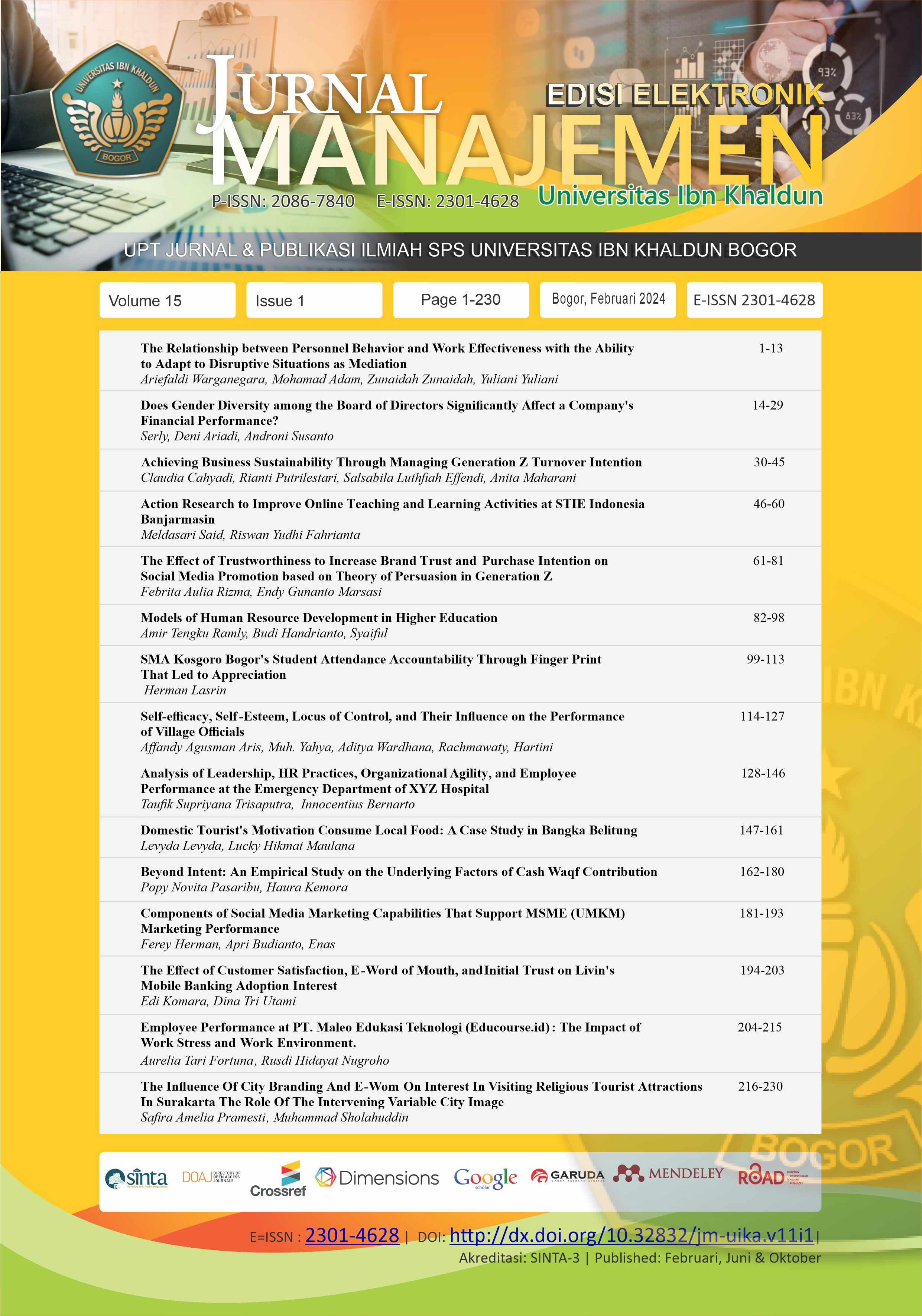The Effect of Customer Satisfaction, E-Word of Mouth, and Initial Trust on Livin's Mobile Banking Adoption Interest
DOI:
https://doi.org/10.32832/jm-uika.v15i1.14771Keywords:
Argument Quality, Valence, consistency, Customer Satisfacion, Mobile Banking Adoption IntentionAbstract
This research aims to investigate the impact of positive Electronic Word of Mouth (eWOM) on the adoption of Mobile Banking. In this study, it was found that Argument Quality, Valence, and Customer Satisfaction have a positive influence on Initial Trust, which in turn affects the intention to adopt Mobile Banking. This study uses a descriptive research design approach with empirical data collected through an online survey of PT Bank X's customer respondents in East Jakarta. The collected data was subsequently analyzed using the Partial Least Square (PLS) analysis method with the aid of smartPLS 4.0 software. The results of this study, there is no positive impact from Consistency and Volume Review on Initial Trust. The findings of this study provide recommendations to banks to leverage positive eWOM to encourage customers to adopt Mobile Banking. These findings emphasize the importance of Customer Satisfaction in enhancing Initial Trust, which contributes to the usage of Mobile Banking applications and Customer Satisfaction
References
Abror, A., Patrisia, D., Engriani, Y., Evanita, S., Yasri, Y., & Dastgir, S. (2020). Service quality, religiosity, Customer Satisfaction, customer engagement and Islamic bank’s customer loyalty. Journal of Islamic Marketing, 11(6), 1691–1705. https://doi.org/10.1108/JIMA-03-2019-0044
Anuraga, G., Sulistiyawan, E., & Munadhiroh, S. (2017). Structural Equation Modeling– Partial Least Square Untuk Pemodelan Indeks Pembangunan Kesehatan Masyarakat (Ipkm) Di Jawa Timur. Seminar Nasional Matematika Dan Aplikasinya, 257.
Chakraborty, U., & Bhat, S. (2018). Credibility of online reviews and its impact on brand image. Management Research Review, 41(1), 148–164. https://doi.org/10.1108/MRR-06- 2017-0173
Farzin, M., Sadeghi, M., Yahyayi Kharkeshi, F., Ruholahpur, H., & Fattahi, M. (2021). Extending UTAUT2 in M-banking adoption and actual use behavior: Does WOM communication matter? Asian Journal of Economics and Banking, 5(2), 136–157. https://doi.org/10.1108/ajeb-10-2020-0085
Ghozali, I., & Latan, H. (2014). Partial Least Squares Konsep, Teknik dan Aplikasi Mengguanakan Program SmartPLS 3.0. Universitas Diponegoro.
Hair, J. F., Hult, G. T. M., Ringle, C. M., & Sarstedt, M. (2017). A primer on partial least squares structural equation modelling (PLS-SEM). In Library of Congress Cataloging-in- Publication Data (Second Edi, Vol. 38, Issue 2). https://doi.org/10.1080/1743727x.2015.1005806
Luo, C., Wentian, L., Fu, X., Zeng, T., & Lan, Y. (2014). Association for Information Systems AIS Electronic Library (AISeL) MANAGING UNCERTAINTY ON EWOM: A COMPARISON STUDY BETWEEN COMMERCIAL AND THIRD PARTY WEBSITES Recommended Citation. 279. http://aisel.aisnet.org/pacis2014http://aisel.aisnet.org/pacis2014/279
Mehrad, D., & Mohammadi, S. (2017). Word of Mouth impact on the adoption of Mobile Banking in Iran. Telematics and Informatics, 34(7), 1351–1363. https://doi.org/10.1016/j.tele.2016.08.009
Quelyu, V. C. De, & Santoso, S. (2021). Peranan Customer Satisfaction dan Customer Commitment terhadap e-WOM dalam Pengguna Aplikasi Gopay di Yogyakarta. Jurnal Nusantara Aplikasi Manajemen Bisnis, 6(1), 1–14. https://doi.org/10.29407/nusamba.v6i1.14533
Shankar, A., & Jebarajakirthy, C. (2019). The influence of e-banking service quality on customer loyalty: A moderated mediation approach. International Journal of Bank Marketing, 37(5), 1119–1142. https://doi.org/10.1108/IJBM-03-2018-0063
Shankar, A., Jebarajakirthy, C., & Ashaduzzaman, M. (2020). How do electronic word of mouth practices contribute to Mobile Banking adoption? Journal of Retailing and Consumer Services, 52(August 2018), 101920. https://doi.org/10.1016/j.jretconser.2019.101920
Shankar, A., & Rishi, B. (2020). Convenience matter in Mobile Banking adoption intention? Australasian Marketing Journal, 28(4), 273–285. https://doi.org/10.1016/j.ausmj.2020.06.008
Sugiyono. (2016). Metode Penelitian Kuantitatif, Kualitatif, dan R&D. Alfabeta.
Van de Scheur, L. (2017). Customer Satisfaction, trust and its influence on co-production and customer loyalty.
Zhou, T. (2011). An empirical examination of initial trust in Mobile Banking. Internet Research, 21(5), 527–540. https://doi.org/10.1108/10662241111176353.
Bankmandiri.co.id. (2023). Edukasi Cara Penggunaan Livin’ by Mandiri. https://bankmandiri.co.id/livin/edukasi
www.cnbcindonesia.com. (2022). No Title. https://www.cnbcindonesia.com/market/20220427163203-17-335425/pengguna-livin- by-mandiri-tembus-11-juta-transaksi-rp-508-t
Https://finansial.bisnis.com/. (2022). Membanding Nilai Transaksi m-Banking BCA (BBCA), BNI (BBNI), dan Mandiri (BMRI), Siapa Juara? https://finansial.bisnis.com/read/20221106/90/1595324/membanding-nilai-transaksi-m- banking-bca-bbca-bni-bbni-dan-mandiri-bmri-siapa-juara
https://money.kompas.com. (2022). Bank Mandiri Dorong Nasabah Beralih ke Super App Livin’ by Mandiri, Apa Saja Fiturnya? Kompas.Com. https://money.kompas.com/read/2022/01/25/130000126/bank-mandiri-dorong-nasabah- beralih-ke-super-app-livin-by-mandiri-apa-saja?page=all
Downloads
Published
How to Cite
Issue
Section
License
Copyright (c) 2024 Jurnal Manajemen (Edisi Elektronik)

This work is licensed under a Creative Commons Attribution-NonCommercial 4.0 International License.
Authors who publish with this journal agree to the following terms:
- Authors retain copyright and grant the journal right of first publication with the work simultaneously licensed under a Creative Commons Attribution-NonCommercial-ShareAlike 4.0 International License that allows others to share the work with an acknowledgement of the work's authorship and initial publication in this journal.
- Authors can enter into separate, additional contractual arrangements for the non-exclusive distribution of the journal's published version of the work (e.g., post it to an institutional repository or publish it in a book), with an acknowledgement of its initial publication in this journal.
- Authors are permitted and encouraged to post their work online (e.g., in institutional repositories or on their website) prior to and during the submission process, as it can lead to productive exchanges, as well as earlier and greater citation of published work (See The Effect of Open Access).











